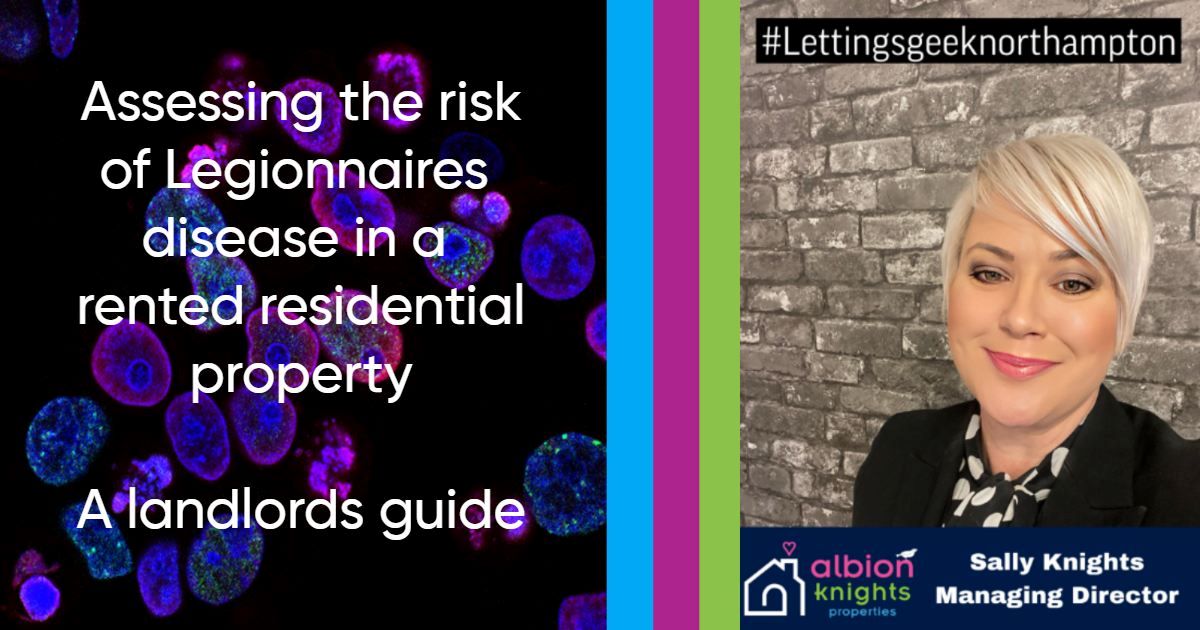
Most landlords that I meet have never given a second thought to the risk of Legionnaires disease in the property they want to rent out. It’s not unusual for a look of utter shock to come over them over them when I start talking about assessing the risk of this potentially fatal disease. I’ve written a comprehensive guide on the why’s and how’s to hopefully make things a little clearer as to why assessing the risk is so important.
As a landlord of a rented residential property in England, it is crucial to prioritize the health and safety of your tenants. One of the key responsibilities is conducting a Legionnaires risk assessment to protect against the potential threat of Legionella bacteria. Legionnaires' disease is a severe form of pneumonia caused by the Legionella bacteria, which can thrive in water systems. In this blog post, we will provide a detailed guide for landlords on conducting a Legionnaires risk assessment, understanding the risks, and implementing necessary measures to prevent Legionella contamination in rented residential properties in England.
Understanding Legionnaires' Disease:
Legionnaires' disease is a potentially fatal respiratory illness caused by inhaling small droplets of water contaminated with Legionella bacteria. Symptoms can range from mild flu-like symptoms to severe pneumonia. It is crucial for landlords to be aware of the risks associated with Legionella bacteria and take appropriate measures to prevent its growth and spread.
Conducting a Legionnaires Risk Assessment:
A Legionnaires risk assessment is a systematic evaluation of the potential sources of Legionella bacteria in a property's water systems. It involves identifying and assessing the risk factors associated with Legionella growth and transmission. Landlords should consider factors such as the type of water system, temperature control, water storage, and the presence of aerosol-generating devices.
Appointing a Competent Person:
Landlords should appoint a competent person to conduct the Legionnaires risk assessment. This person should have the necessary knowledge, skills, and experience to identify and assess the risks associated with Legionella contamination. They may be an external consultant or a qualified member of the landlord's team.
Identifying Risk Factors:
During the risk assessment, the competent person should identify potential risk factors for Legionella growth and transmission. These may include stagnant water, inadequate temperature control, dead legs in the plumbing system, and infrequently used outlets or showers. The assessment should also consider vulnerable individuals, such as the elderly or those with compromised immune systems.
Implementing Control Measures:
Based on the findings of the Legionnaires risk assessment, landlords should implement appropriate control measures to minimize the risk of Legionella contamination. This may include regular monitoring and maintenance of water systems, ensuring appropriate temperature control, and implementing water treatment measures such as chlorination or thermal disinfection.
Documentation and Record-Keeping:
Landlords should maintain detailed records of the Legionnaires risk assessment, including the findings, control measures implemented, and any subsequent actions taken. These records demonstrate compliance with legal requirements and can be useful for future reference or inspections.
Tenant Education and Communication:
Landlords should educate and communicate with tenants about Legionnaires' disease and the control measures in place. This can be done through informational leaflets, the tenancy agreement, or verbal communication. Tenants should be encouraged to report any concerns about water quality, temperature, or other potential risks.
Regular Review and Monitoring:
Legionella risk assessments should be reviewed regularly, especially if there are any changes to the water systems or occupancy of the property. Landlords should also establish a regular monitoring program to ensure ongoing compliance with control measures and identify any potential issues promptly.
Conducting a Legionnaires risk assessment is a crucial responsibility for landlords of rented residential properties in England. By understanding the risks associated with Legionella bacteria, implementing appropriate control measures, and maintaining accurate records, landlords can protect the health and safety of their tenants. Regular review, monitoring, and tenant education are essential for ongoing prevention and compliance. By prioritizing Legionnaires risk assessment, landlords can create a safe living environment and fulfil their duty of care to their tenants.
Legislation alert! - here is the all-important legal bits to back everything up:
Landlords of residential properties in England are required to assess the risk of Legionnaires' disease under the following legislation:
The Health and Safety at Work Act 1974:
This act is the primary legislation that governs health and safety in the workplace, including residential rental properties. Landlords have a legal duty under this act to ensure the health and safety of their tenants, which includes protecting them from the risk of Legionella contamination.
The Control of Substances Hazardous to Health (COSHH) Regulations 2002:
The COSHH regulations require landlords to assess and control the risks associated with hazardous substances, including Legionella bacteria. Landlords must conduct a risk assessment to identify and evaluate the potential sources of Legionella contamination in their properties.
The Approved Code of Practice (ACOP) L8:
The ACOP L8 provides practical guidance on controlling the risk of Legionella in the workplace, including residential properties. Landlords are encouraged to follow the recommendations outlined in the ACOP L8 to prevent Legionella contamination and ensure the safety of their tenants.
These legislations collectively require landlords to assess and manage the risk of Legionnaires' disease in residential properties to protect the health and safety of tenants. Failure to comply with these regulations can result in penalties and legal consequences.
Thanks for reading ......until next time
Yours in property
Sally



